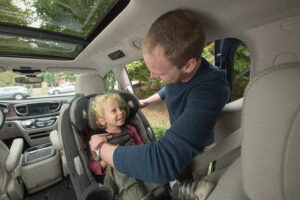
NHTSA sets new child seat safety standards
By onAnnouncements
A series of Consumer Reports (CR) car seat recommendations recently became National Highway Traffic Safety Administration (NHTSA) federal standards, according to a Consumer Reports press release.
“Consumer Reports tests and rates over 100 car seats for safety in a crash, fit in vehicles, and ease of use to help consumers make informed decisions and choose the right car seat for their needs,” the CR release said. “CR and other safety organizations have been calling for significant improvements to the NHTSA car seat requirements for years.”
The new standards update owner registration program requirements to help consumers get information about car seat recalls. It also requires product labels on car seats that specify child weight minimums for each usage mode.
Multiple testing methods are updated by the standards, including:
-
- Updating the test bench to better reflect the geometry and stiffness of modern vehicle seats.
- Establishing test conditions and performance minimums for child seats in a side impact test.
- Introducing test conditions using a lap-and-shoulder seat belt rather than a lap belt only.
- Using test dummies that best represent the weight ranges where child seats are most commonly used.
“Parents and caregivers deserve the peace of mind that comes with knowing a car seat is rigorously tested to comply with strong safety rules,” said Gabe Knight, safety policy analyst for Consumer Reports, in the CR release. “While NHTSA could have gone further, this improved safety standard is a crucial step forward. We urge car seat manufacturers to hit the ground running and meet the new requirements as soon as possible.”
The standards also provide bus-specific restraint system requirements.
NHTSA’s website says 46% of car and booster seats are misused.
Resources found on the NHTSA website include:
-
- Recommendations for child’s age and size
- Tips for finding the right car seat for different vehicle types
- Overview of car seat and vehicle parts
- Instructions on how to install rear-facing, forward-facing and booster seats can be found on zip A zip code searchable database of locations for car seat inspections
- Registration for manufacturer recalls
Collision repairers have a unique opportunity to help keep children safe through workshops, advocacy and by providing guidance.
Collision repair businesses can consider hosting or promoting community events led by nationally certified child passenger safety technicians (CPS).
Business owners can also encourage employees to enroll in the four-day CPS certification course to ensure car seats are correctly reinstalled following service.
According to the NHTSA, car seats do not need to be swapped out if a crash is minor. To qualify as such, it said all of the following boxes must be checked:
-
- The vehicle was driven away from the crash site
- The vehicle door closest to the car seat wasn’t damaged
- No passengers were injured
- Airbags did not deploy if the vehicle is equipped with airbags
- There is no visible damage to the seat
If the above conditions aren’t met, the NHTSA said the car seat should be replaced. If they are, the federal agency said buying a new seat isn’t necessary, although some car seat manufacturers have taken a different stance.
IMAGES
Photo courtesy of NHTSA
